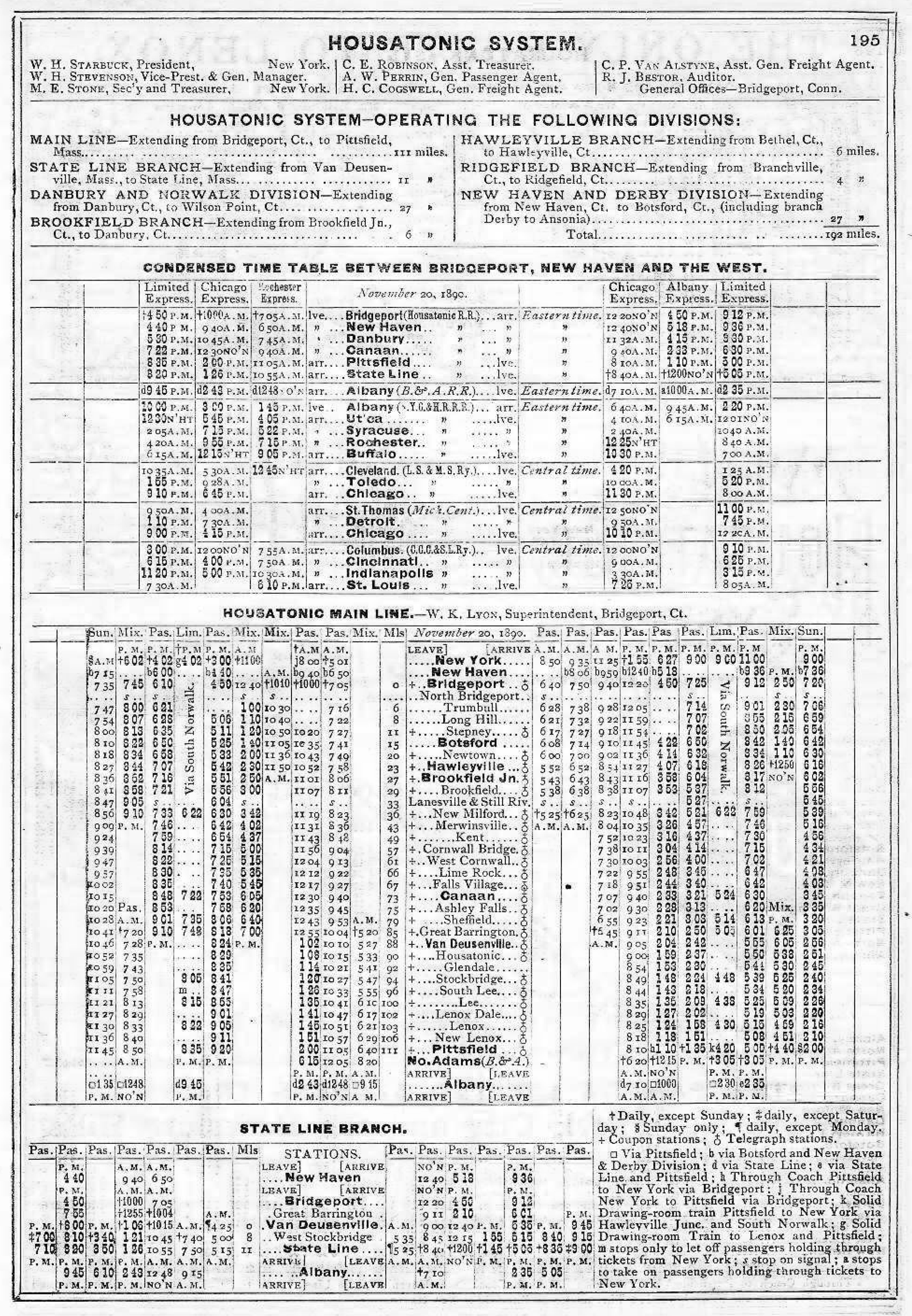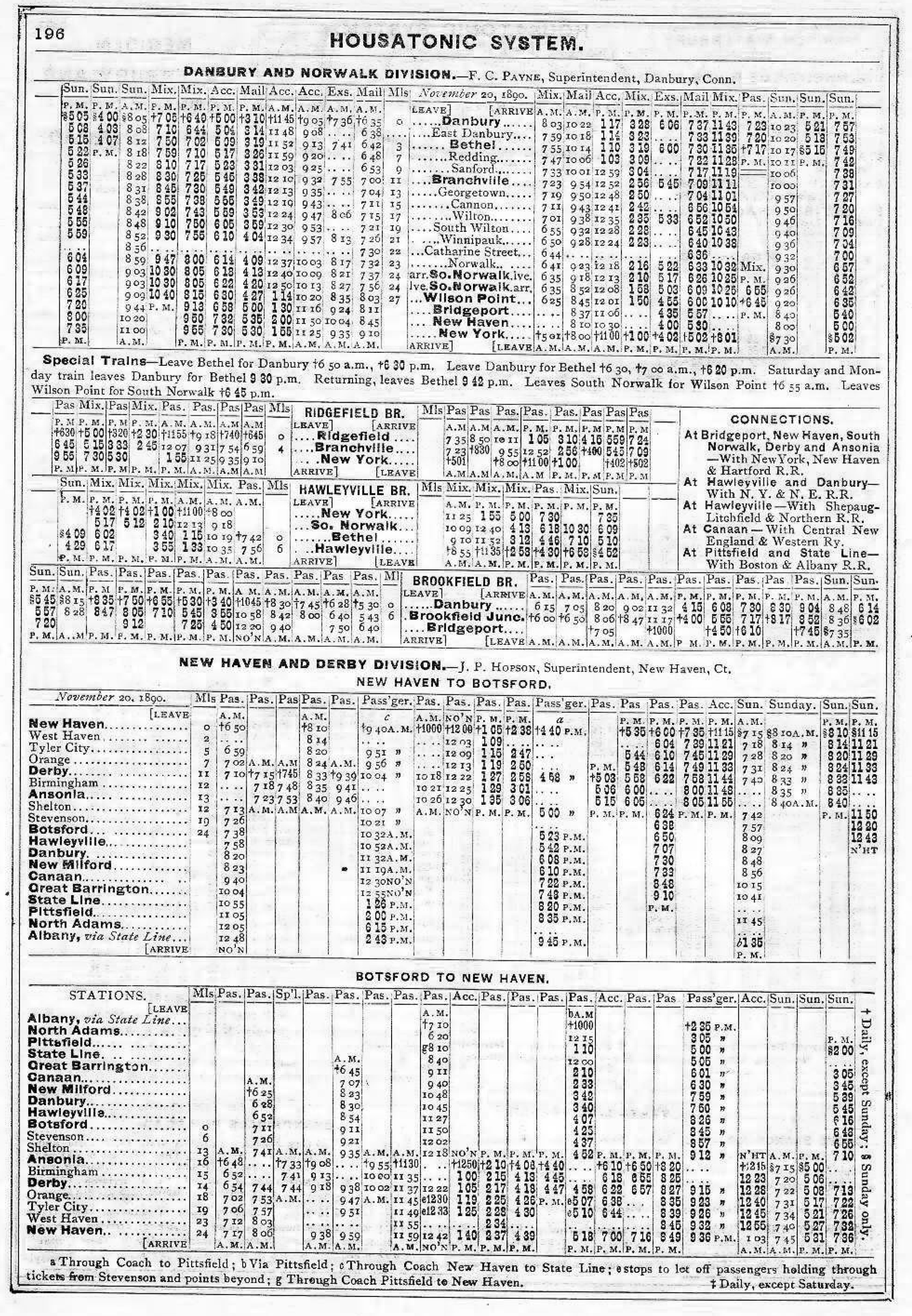Housatonic Railroad: "The Berkshire Hills Route"
Published: August 3, 2024
By: Adam Burns
The Housatonic Railroad is an historic New England system that linked western Connecticut with western Massachusetts. At its peak, the north-south corridor stretched 189 miles connecting South Norwalk, CT with Pittsfield, MA.
It also maintained branches to Bridgeport, New Haven, and Ridgefield, CT as well as State Line, MA. In 1892 the Housatonic was acquired by the New Haven and became its Berkshire Division.
Under the New Haven components of the original network were abandoned and what remained was rolled into Penn Central in 1969. Following Conrail's 1976 creation the carrier continued to shed what it deemed redundant trackage.
A section of the original main line, 34 miles, was subsuquently leased to John Hanlon Jr. who chartered a new Housatonic Railroad in 1983. Today, the short line has pieced together an even larger system totaling 161 miles currently that even stretches into eastern New York.
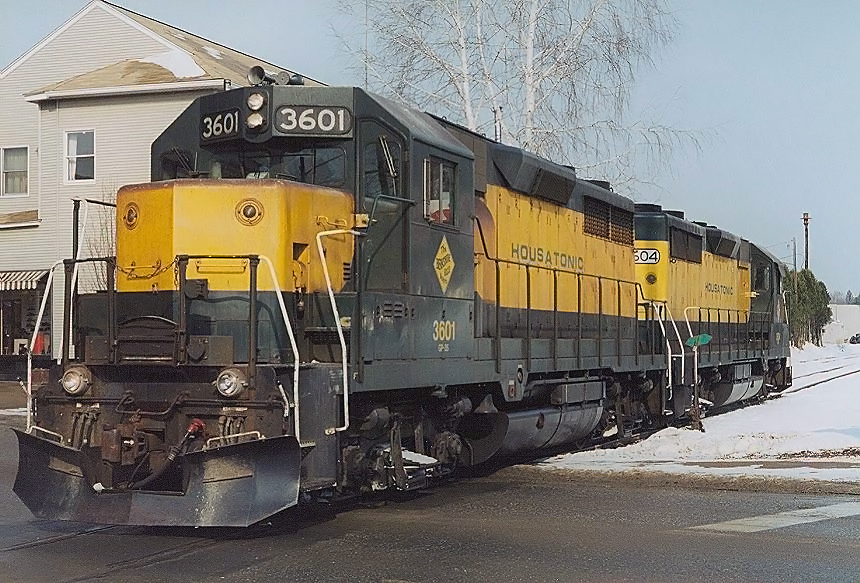 Housatonic Railroad GP35s #3601 and #3604 cross Route 44 in Canaan, Connecticut as they perform some switching on January 27, 2001. Canaan is the shop and operational headquarters of the line. Doug Kroll photo.
Housatonic Railroad GP35s #3601 and #3604 cross Route 44 in Canaan, Connecticut as they perform some switching on January 27, 2001. Canaan is the shop and operational headquarters of the line. Doug Kroll photo.The Original Housatonic
The historic Housatonic Railroad was chartered in May 1836 to construct a rail line from Bridgeport, Connecticut, northward to the Massachusetts state line, following the Housatonic River valley. Regular service commenced from Bridgeport to New Milford on February 19, 1840, and the line reached Massachusetts on December 1, 1842.
Subsidiaries
Beyond the original Housatonic's main line the railroad also acquired, or financed, a handful of other railroads. These included the Berkshire Railroad, West Stockbridge Railroad, Danbury & Norwalk Railroad and New Haven & Danbury Railroad.
Berkshire Railroad
The Berkshire Railroad was incorporated on April 13, 1837, with intentions of extending the line further north beyond the state line to West Stockbridge. This extension was planned to connect with the West Stockbridge Railroad and the unbuilt Lee & Hudson Railroad.
Construction began in February 1841 and was completed on December 1, 1842. It was subsequently leased by the Housatonic on January 1, 1843.
The West Stockbridge Railroad was chartered in 1831 and incorporated on April 5, 1836, to operate from West Stockbridge westward to State Line, eventually continuing to the Hudson River in New York State as the Hudson & Berkshire Railroad. This line began service on August 10, 1838.
On February 6, 1844, the Berkshire Railroad leased both the West Stockbridge and Hudson & Berkshire.
The latter's involvement with the Houstonic ended on November 21, 1854 when the Western Railroad acquired the system, which later became a component of the larger Boston & Albany (New York Central).
The final segment of the main line was formalized on March 20, 1847, as the Stockbridge & Pittsfield Railroad. This system diverged from the main line at Van Deusenville and extended eastward and northward to Pittsfield. It opened for service on January 1, 1850 and was leased by the Housatonic Railroad on January 25th.
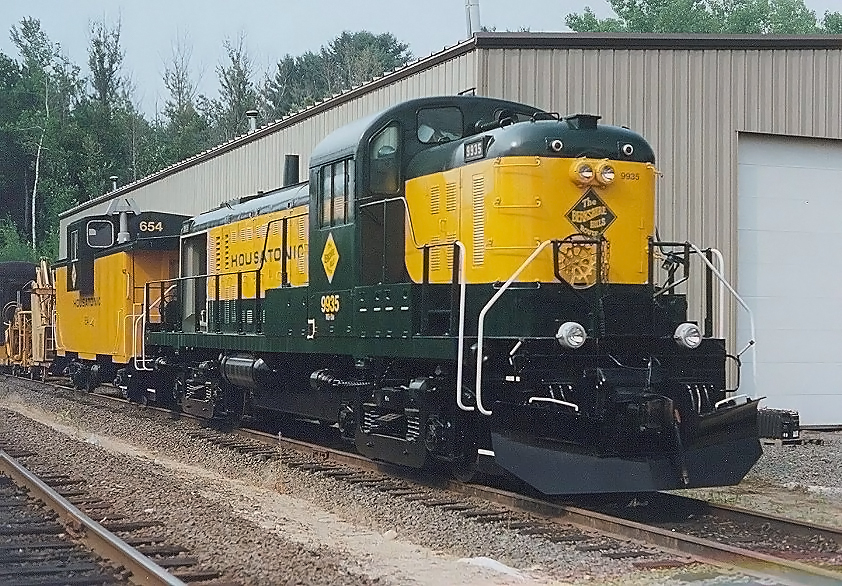 Housatonic Railroad RS3m #9935 was the first road-switcher acquired by the Housatonic. The unit was re-engined with an EMD 567 by Conrail at Altoona, Pennsylvania in 1979. The unit was built as Erie Lackawanna RS3 #1048. It is seen here at the Canaan Shops on June 27, 1999. Doug Kroll photo.
Housatonic Railroad RS3m #9935 was the first road-switcher acquired by the Housatonic. The unit was re-engined with an EMD 567 by Conrail at Altoona, Pennsylvania in 1979. The unit was built as Erie Lackawanna RS3 #1048. It is seen here at the Canaan Shops on June 27, 1999. Doug Kroll photo.Branches
There were various short branches comprising the system, largely located at the southern end of the system linking such Connecticut towns as New Haven and South Norwalk. These lines were constructed by the Danbury & Norwalk and New Haven & Danbury railroad.
The Danbury & Norwalk began operations in 1852, connecting Danbury to Norwalk. In 1863, the New York, Housatonic & Northern Railroad was chartered to run from White Plains, New York, to Brookfield, Connecticut, via Danbury.
However, it only extended north of Danbury and was leased by the Housatonic Railroad in 1874, which subsequently purchased it in 1881.
The Housatonic further leased the Danbury & Norwalk in 1887, including its branches to Ridgefield, Hawleyville, and an extension to Wilson Point.
Simultaneously, the New Haven & Derby Railroad, chartered in 1864, commenced operations in 1871 from New Haven to Derby and Ansonia, Connecticut.
An extension from Derby Junction to Shelton was opened in 1888, with further construction to Botsford completed by the Housatonic the same year. The Housatonic leased this line in 1889.
Finally, the New York, New Haven & Hartford Railroad leased the Housatonic Railroad on July 1, 1892, creating the Berkshire Division, which was fully merged into its considerable network on March 29, 1898.
System Map (1891)
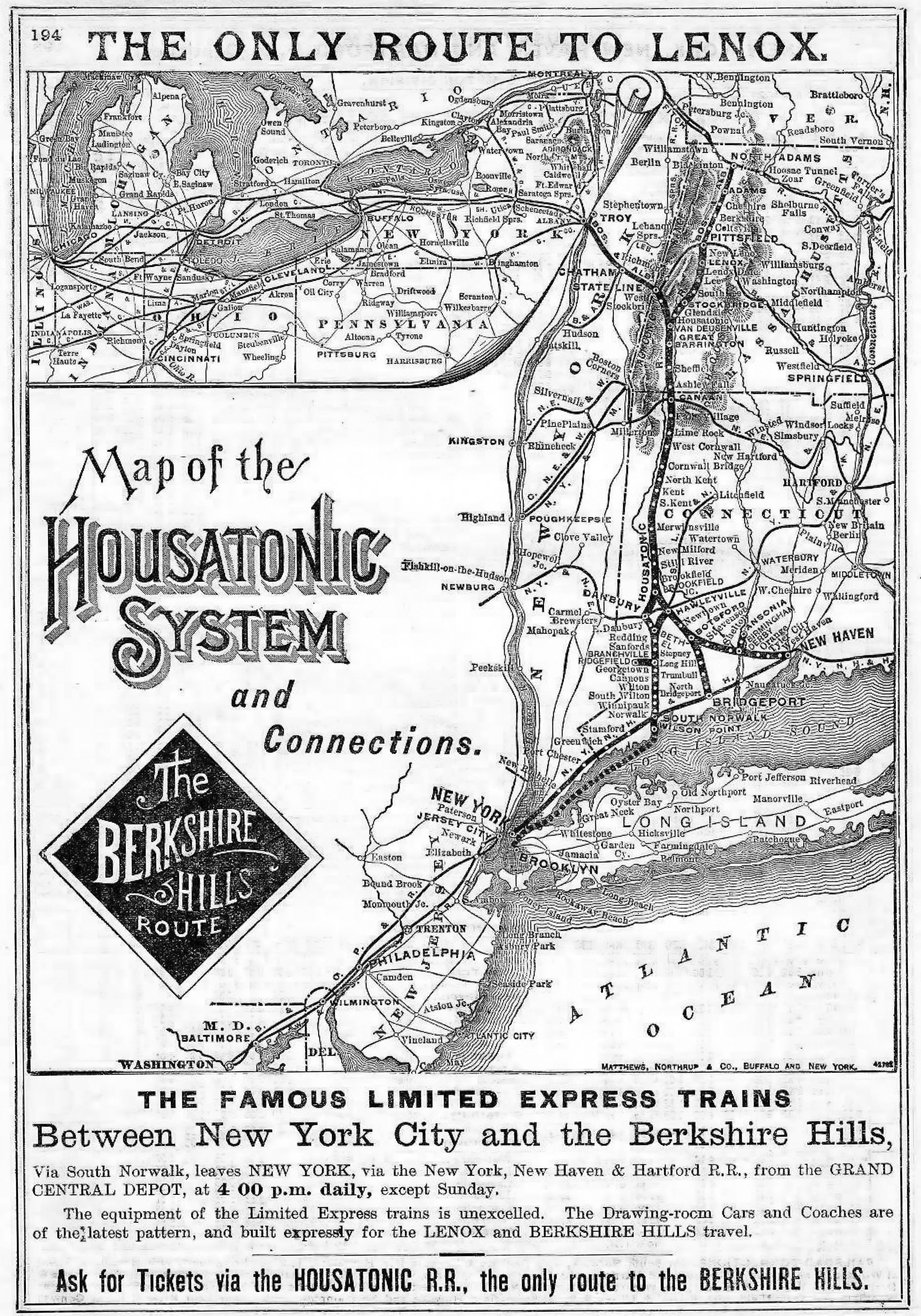
New York, New Haven & Hartford
Under the New Haven much of the original Housatonic system remained operational although short segments were abandoned such as the main line south of Botsford, as well as between Brookfield and Hawleyville. In addition, most of the branches had been removed by the time the New Haven joined Penn Central in 1969.
Timetables (1891)
The Modern Housatonic
With Conrail's April 1, 1976 startup the new conglomerate immediately mothballed thousands of miles of redundant trackage throughout the Northeast and Midwest. One such corridor was the remaining Housatonic.
The state of Connecticut ultimately acquired the trackage between Canaan and New Milford to save it from abandonment while the Boston & Maine purchased the remaining trackage north of Canaan.
In 1983, John Hanlon Jr. chartered a new Housatonic Railroad (reporting mark, HHRC) to lease 34 miles of the former line from Boardman Bridge in New Milford to Canaan from the state. By November 1984, the company had commenced service between Canaan and just south of Cornwall Bridge at Belsprings Siding.
The remaining section leading to New Milford was restored by 1989, enabling connections with both the Boston and Maine Railroad (then Guilford) in Canaan and Conrail in New Milford.
Throughout the 1990s the system continued to grow, eventually running as far west as Beacon, New York and as far east as Derby/Shelton, Connecticut. It has also extended service as far north as Pittsfield, Massachusetts.
Former Excursions
In 1984, the Berkshire Scenic Railway Museum began offering passenger excursions between Lee and Great Barrington on the Housatonic Railroad. However, due to deteriorating track conditions, these operations were suspended in 1989.
Diesel Roster
| Road Number | Model Type | Completion Date | Builder | Serial Number | Heritage |
|---|---|---|---|---|---|
| 2 | 45-Tonner | 2/1942 | GE | 15157 | Out of service. ex-Remington Arms #2. |
| 22 | GP7u | 2/1952 | EMD | 15882 | ex-Bangor & Aroostook #22; ex-Santa Fe #2227 (2nd); built as Santa Fe GP7 #2722. |
| 1802 | GP9 | 5/1954 | EMD | 19485 | ex-West Virginia Central #6641; ex-Providence & Worcester #1802; ex-Connecticut Cenral Line #53; ex-Southern Pacific #3191/#3010; built as Southern Pacific/T&NO #283. |
| 2737 | GP38 | 9/1969 | EMD | 35267 | ex-Norfolk Southern #2737; built as Southern #2737. |
| 3600 | GP35m | 11/1964 | EMD | 29617 | ex-Conrail #2250; ex-Penn Central #2250; ex-PRR #2250; built as PRR GP35 #2309. |
| 3601 | GP35 | 1/1965 | EMD | 30329 | Ex-HLCX #2312; ex-Conrail #2312; ex-Penn Central #2312; built as PRR #2312. |
| 3602 | GP35m | 5/1964 | EMD | 29003 | ex-HLCX #3602; ex-Conrail #2254; ex-Penn Central #2254; ex-PRR GP35 #2254. |
| 3603 | GP35 | 2/1965 | EMD | 30353 | Out-of-service. ex-HLCX 3603; ex-Conrail #2336; ex-Penn Central #2236; ex-PRR #2336. |
| 3604 | GP35 | 1/1965 | EMD | 30331 | ex-HLCX #3604; ex-Conrail #2314; ex-Penn Central #2314; built as PRR #2314. |
| 7324 | GP9 | 11/1955 | EMD | 20913 | Sold to New Hampshire. ex-Conrail #7324; ex-Penn Central #7324; ex-New York Central #7423; built as New York Central #5924. |
| 9935 | RS3m | 4/1951 | Alco | 78578 | ex-Conrail #9935; ex-Conrail #5264; built as Erie Lackawanna RS3 #1048. |
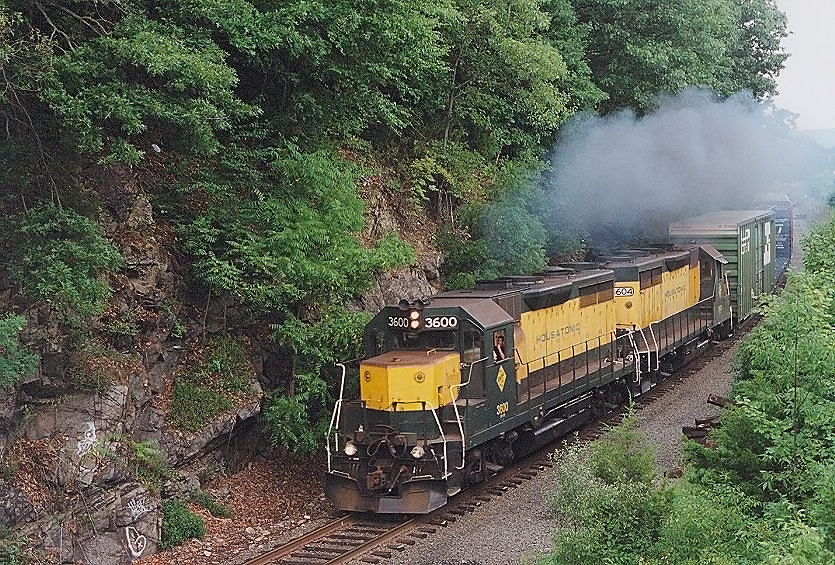 Housatonic GP35s #3600 and #3604 have train NX-11 heading west as it leaves Hawleyville, Connecticut and passes under Farrell Road on August 27, 1999. Doug Kroll photo.
Housatonic GP35s #3600 and #3604 have train NX-11 heading west as it leaves Hawleyville, Connecticut and passes under Farrell Road on August 27, 1999. Doug Kroll photo.The museum successfully lobbied for state assistance funds, and following repairs, passenger excursions resumed in 2003. These trips were based out of the newly restored station in Lenox and operated regularly to Lee and Stockbridge. They continued until 2011 when the Housatonic discontinued allowing these public trips.
Current Freight Traffic
The railroad currently serves several customers a wide range of industries and its traffic base consists of lumber, waste diposal, corrugated steel, paper, food, plastics, limestone, and a variety of small manufacturing firms.
Recent Articles
-
Washington Thomas The Train Rides
Dec 21, 25 04:57 PM
This article will take you on a detailed journey through A Day Out With Thomas events held in Washington, offering insights into what makes this experience extraordinary for families and railroad enth… -
Pennsylvania Thomas The Train Rides
Dec 21, 25 03:52 PM
"A Day Out With Thomas” train rides offer a unique opportunity for children and their families to engage in a magical and memorable experience, setting the stage for a full day of fun and adventure. -
Illinois Thomas The Train Rides
Dec 21, 25 12:30 PM
In Illinois, the "A Day Out With Thomas" event offers a unique chance for families to immerse themselves in the enchanting world of Thomas and friends, creating memories that last a lifetime.

